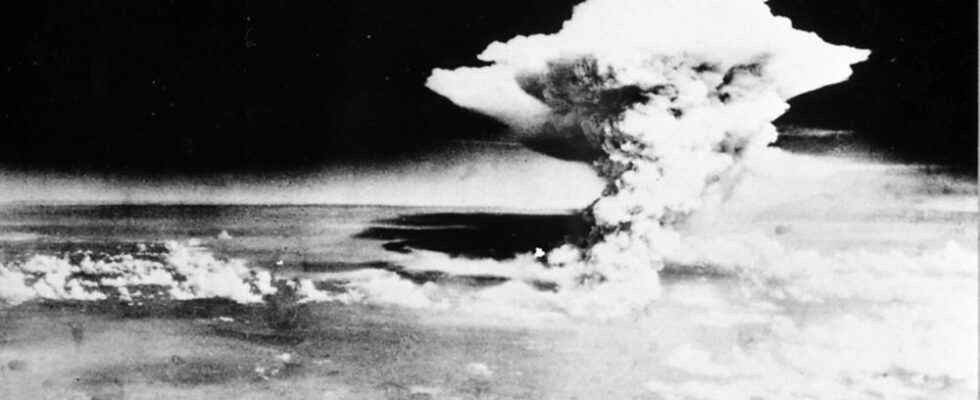It sounds like the title of a novel: “Escalade for de-escalation”. But, in reality, this is how the experts designate the most feared scenario in Ukraine, taken seriously by the Western military: that of the use of atomic weapons. To bend kyiv, especially if it sees victory slipping away from it, Russia could resort to it. A taboo would then be broken. Because since the end of the Second World War and the bombings of Hiroshima and Nagasaki (more than 200,000 dead in all), no power has dared to drop nuclear bombs on an enemy.
Specialists in the matter are particularly concerned that Moscow will call for so-called “tactical” nuclear weapons – a term long associated with the Cold War period on the European continent. “It differs from the ‘strategic’ nuclear weapon by its lesser range and by the idea that it could be used in the theater of operations”, specifies Benoît Pelopidas, founder of the program for the study of nuclear knowledge (Sciences Po , CERI) and author of Rethinking nuclear choices (Sciences Po Press).
Important point: the power of the “tactical” weapon is not necessarily inferior to that of the strategic nuclear weapon, the most well-known vector of which is the intercontinental ballistic missile. Fired from a silo or a ballistic missile submarine (SNLE), the strategic nuclear weapon quite simply goes further than the tactical weapon. And its effects are devastating: a French M-51 missile warhead corresponds, for example, to 100,000 tons of TNT (100 kilotons). By way of comparison, the power of the bombs used in Japan, in August 1945, by the American army, was around 15 KT. Often presented as the last American tactical nuclear weapon, the B61 can accommodate loads of variable size, from 0.3 to more than 100 KT. The United States has about 200 missiles of this type, including a hundred on the European continent.
The authoritative Federation of American Scientists bulletin estimates that Russia has about 1,900 “tactical” nuclear warheads. Some of these charges can be mounted in the missiles carried by the launcher trucks of the Iskander system, used since the beginning of the Russian invasion to carry out “conventional” strikes on Ukrainian targets.
The atomic bombs dropped on Japan claimed over 200,000 lives.
AFP
Will Putin dare to replace the conventional warheads of these missiles with nuclear warheads? The Russian military posture – these are documents more than real doctrine – stipulates that nuclear weapons can be used in the event that “aggression with conventional weapons would endanger the very existence of the state” . However, as Benoît Pelopidas notes, “Putin’s remarks at the time of the entry into the war maintains the possibility of the use of tactical weapons, so we must not believe that it is strictly impossible”.
Such use would plunge the world into the unknown. “It is wiser to speak of non-strategic rather than tactical weapons, because any nuclear weapon has effects that go beyond the battlefield, which is why, moreover, the former Minister of Defense of Donald Trump, General James Mattis, refused to make a distinction between tactical and strategic weapons,” says researcher Benjamin Hautecouverture, from the Foundation for Strategic Research (FRS).
The arms race reignited
However, the “non-strategic” nuclear arms race has resumed between Moscow and Washington, which withdrew one after the other, in the summer of 2019, from the treaty on intermediate nuclear forces (INF), concerning land-based missiles with a range of between 500 and 5,500 kilometres. This bilateral treaty signed in 1987 by the leader of the USSR Mikhail Gorbachev and US President Ronald Reagan allowed the dismantling of all medium and intermediate range ground-to-ground weapons (2,692 warheads). It had thus put an end to the Euromissile crisis and constituted a crucial chapter in the process of reducing nuclear weapons between the two great powers.
The Americans consider that the Russians, with their new 9M729 missile (NATO code SSC-8), have violated the INF treaty. “The Trump administration, in response to what is perceived to be an increasing Russian non-strategic nuclear threat, has decided to initiate development of a new low-power warhead for ballistic missiles launched from submarines and “a new naval cruise missile, indicates Benjamin Hautecouverture. Joe Biden must unveil in the coming weeks the new American nuclear posture. In the context of the war in Ukraine, we will see whether or not he maintains these programs that he had criticized during his campaign.”
It seems improbable, on the other hand, to see France return soon to this type of armament. The collapse of the USSR had removed the fear of a Soviet invasion and the idea that only tactical nuclear weapons could have stopped it – without resorting to strategic weapons. Mounted on tractor-erector-launchers, its Pluton missiles were withdrawn in 1993. Their successors, the Hades, with a maximum range of 480 km, suffered the same fate four years later. An approach to which Russia has never resolved.
